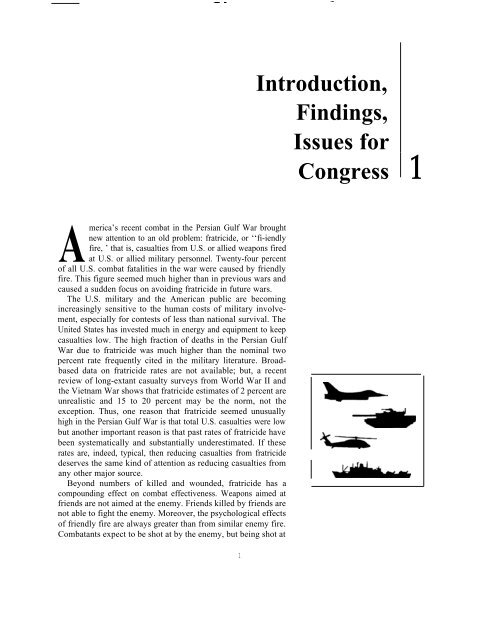Who Goes There: Friend or Foe? - Federation of American Scientists
Who Goes There: Friend or Foe? - Federation of American Scientists
Who Goes There: Friend or Foe? - Federation of American Scientists
Create successful ePaper yourself
Turn your PDF publications into a flip-book with our unique Google optimized e-Paper software.
— —<br />
America’s recent combat in the Persian Gulf War brought<br />
new attention to an old problem: fratricide, <strong>or</strong> ‘‘fi-iendly<br />
fire, ’ that is, casualties from U.S. <strong>or</strong> allied weapons fired<br />
at U.S. <strong>or</strong> allied military personnel. Twenty-four percent<br />
<strong>of</strong> all U.S. combat fatalities in the war were caused by friendly<br />
fire. This figure seemed much higher than in previous wars and<br />
caused a sudden focus on avoiding fratricide in future wars.<br />
The U.S. military and the <strong>American</strong> public are becoming<br />
increasingly sensitive to the human costs <strong>of</strong> military involvement,<br />
especially f<strong>or</strong> contests <strong>of</strong> less than national survival. The<br />
United States has invested much in energy and equipment to keep<br />
casualties low. The high fraction <strong>of</strong> deaths in the Persian Gulf<br />
War due to fratricide was much higher than the nominal two<br />
percent rate frequently cited in the military literature. Broadbased<br />
data on fratricide rates are not available; but, a recent<br />
review <strong>of</strong> long-extant casualty surveys from W<strong>or</strong>ld War II and<br />
the Vietnam War shows that fratricide estimates <strong>of</strong> 2 percent are<br />
unrealistic and 15 to 20 percent may be the n<strong>or</strong>m, not the<br />
exception. Thus, one reason that fratricide seemed unusually<br />
high in the Persian Gulf War is that total U.S. casualties were low<br />
but another imp<strong>or</strong>tant reason is that past rates <strong>of</strong> fratricide have<br />
been systematically and substantially underestimated. If these<br />
rates are, indeed, typical, then reducing casualties from fratricide<br />
deserves the same kind <strong>of</strong> attention as reducing casualties from<br />
any other maj<strong>or</strong> source.<br />
Beyond numbers <strong>of</strong> killed and wounded, fratricide has a<br />
compounding effect on combat effectiveness. Weapons aimed at<br />
friends are not aimed at the enemy. <strong>Friend</strong>s killed by friends are<br />
not able to fight the enemy. M<strong>or</strong>eover, the psychological effects<br />
<strong>of</strong> friendly fire are always greater than from similar enemy fire.<br />
Combatants expect to be shot at by the enemy, but being shot at<br />
1<br />
Introduction,<br />
Findings,<br />
Issues f<strong>or</strong><br />
Congress 1
















